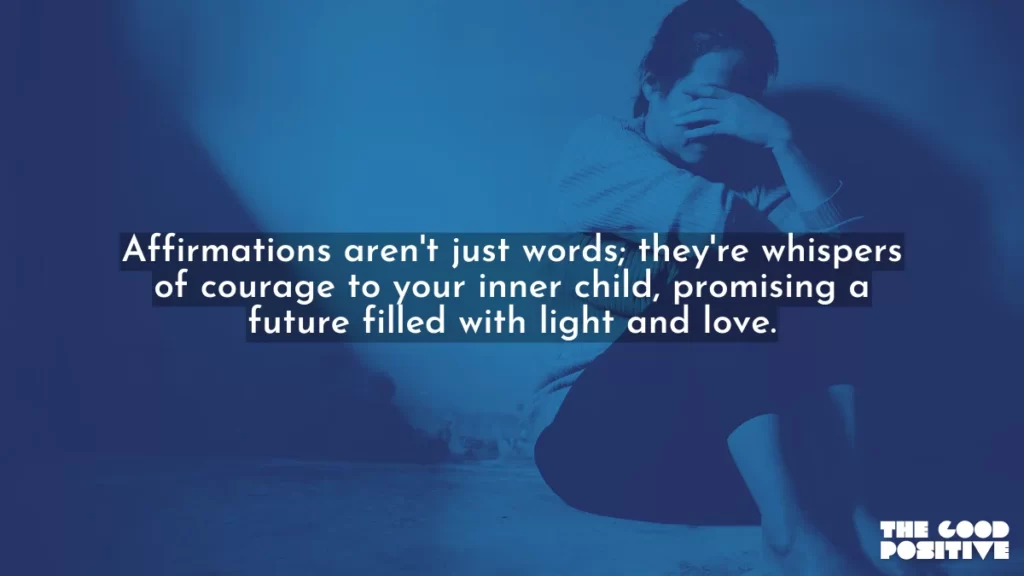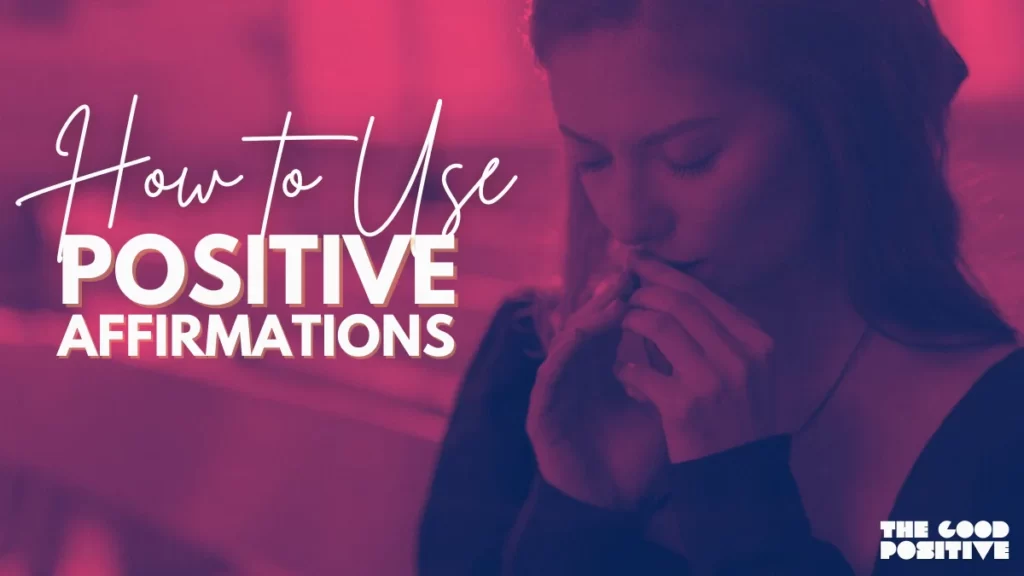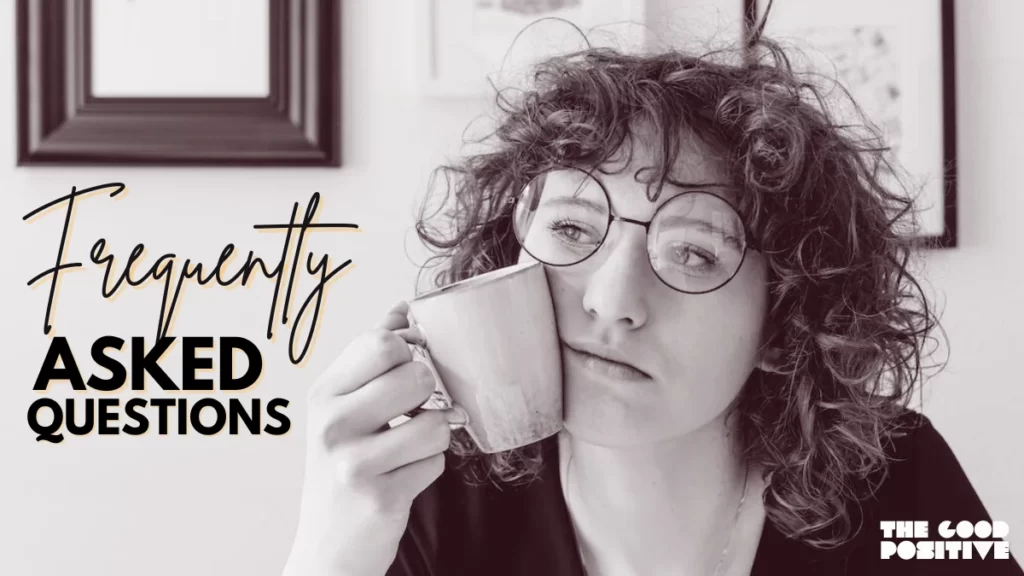Positive Affirmations for Childhood Trauma, you might wonder, “Can words truly heal?” I’m here to share a secret with you. As someone who has walked the tough path of overcoming the shadows of the past, I can say, yes, they can.
Picture this: each affirmation is a gentle brushstroke on the canvas of your soul, painting over old scars with vibrant new hues of strength and self-love.
You’re not just reciting words; you’re weaving a new narrative, one where you’re the hero, not the victim.
So, let’s embark on this transformative journey together, where each affirmation is a step towards the light at the end of the tunnel, a light that you kindle within yourself.
Table of Contents
Affirm More: Positive Affirmations for Charisma.
Why Use Positive Affirmations For Childhood Trauma?

Why use childhood trauma affirmations? you might ponder. It’s like giving your inner child a nurturing embrace after a long, stormy night.
Here’s why they’re not just words, but powerful tools for healing:
1. Healing Old Wounds: Imagine each affirmation as a soothing balm on past scars. They gently remind you that your past doesn’t define your future. Like a tree growing stronger after a storm, these affirmations help your spirit flourish.
2. Boosting Self-Worth: You know, Maya Angelou once said, “I am a Woman Phenomenally.” Despite her traumatic childhood, she used the power of words to rise. Similarly, affirmations can be your daily dose of self-love, reminding you of your inherent worth.
3. Creating Positive Mental Pathways: Every “I am strong” or “I am worthy” is like building a bridge over troubled waters in your mind. Over time, these bridges become your new pathways of thinking, leading you away from pain and towards healing.
4. Fostering Resilience: They’re your armor in the battle against lingering shadows. Like Kintsugi, the Japanese art of repairing broken pottery with gold, affirmations help you find beauty and strength in your broken parts.
5. Igniting Hope: Each positive statement is a spark of hope in the darkness of trauma. They’re like stars guiding sailors at sea, leading you towards a brighter horizon.
Affirmations aren’t just words; they’re whispers of courage to your inner child, promising a future filled with light and love. Let’s start this journey together, with hope as our compass.
100 Positive Affirmations For Childhood Trauma

If you’ve ever felt like your past shadows are too heavy to carry, this is for you.
Imagine we’re sitting together, sipping our favorite tea, as I gently remind you of the strength and light within you. Each affirmation is a small lantern, helping to guide you through the darker paths of your memories.
Remember, our journey together is about healing and rediscovering your incredible inner brilliance.
🔖 I encourage you to bookmark this page – think of it as your personal treasure map to a more peaceful you. And here’s a magical tip: recite these affirmations daily for 21 days.
Just like watering a plant, this daily practice can nurture your spirit, helping new, positive beliefs to bloom within you. Let’s embark on this healing journey together, shall we?
1. “I am moving beyond the trauma of my childhood.”
2. “My past does not define my future.”
3. “I am resilient, rising above my childhood adversities.”
4. “Every day, I grow stronger than my childhood fears.”
5. “I am healing from the stress of past events.”
6. “My resilience shines brighter than any trauma I’ve faced.”
7. “I am not defined by the trauma I experienced as a child.”
8. “I am safe now, far from past dangers.”
9. “I am rewriting my story, beyond childhood violence.”
10. “My life is no longer overshadowed by threatening memories.”
11. “I am creating new, positive experiences every day.”
12. “I protect my peace, distancing from unsafe pasts.”
13. “I am healing from childhood abuse with strength and love.”
14. “Every breath I take is a step away from past accidents.”
15. “I am stronger than the disasters I faced in childhood.”
16. “I rise above the bullying of my past.”
17. “My health is a priority, healing both mind and body.”
18. “I let go of anger and welcome peace.”
19. “I am more than any aggressive acts I endured.”
20. “I choose happiness over feeling depressed.”
21. “I am overcoming anxiety with calmness and clarity.”
22. “My sleep is peaceful, free from the haunts of trauma.”
23. “I embrace reality with courage and optimism.”
24. “I control my emotions, they do not control me.”
25. “I find joy in everyday activities, big and small.”
26. “My development is a journey of continuous growth.”
27. “I let go of sadness, embracing joy and laughter.”
28. “My brain is healing, rewiring for happiness and peace.”
29. “I nurture my physical health, as it supports my mental well-being.”
30. “My mental strength is my superpower.”
31. “I foster positive social connections for a balanced life.”
32. “I release the pain of the past, embracing the present.”
33. “My memories are mine to cherish, not to fear.”
34. “I am building healthy relationships, free from past traumas.”
35. “I find love and support in my chosen family.”
36. “I understand my childhood, but I am not trapped by it.”
37. “My caregiver’s actions do not reflect my worth.”
38. “I am exploring psychology to understand and heal myself.”
39. “My feelings are valid and important.”
40. “I am reducing anxiety by embracing peace and calm.”
41. “Every day is a step towards healing my inner child.”
42. “I am not alone; my experiences unite me with others.”
43. “I am rewriting my narrative with hope and positivity.”
44. “My childhood trauma is a chapter, not my whole story.”
45. “I find strength in my vulnerability and openness.”
46. “I am a survivor, not a victim, of my past.”
47. “I acknowledge my trauma but refuse to be its hostage.”
48. “I am creating a life filled with love and respect.”
49. “My experiences have taught me empathy and understanding.”
50. “I am a beacon of hope for others who’ve suffered.”
51. “I embrace the lessons of my past with gratitude.”
52. “I am capable of overcoming any obstacle.”
53. “I choose to focus on building a joyful future.”
54. “I am deserving of love, despite my childhood experiences.”
55. “My journey is unique and valuable.”
56. “I am a testament to the power of healing.”
57. “I release old patterns and embrace new possibilities.”
58. “I am worthy of a life free from fear and pain.”
59. “I trust in my ability to navigate life’s challenges.”
60. “I am proud of who I’ve become, despite my past.”
61. “I am the architect of my happiness and peace.”
62. “I am surrounded by love, support, and positivity.”
63. “I am breaking free from the chains of my trauma.”
64. “My courage is stronger than any childhood adversity.”
65. “I am a warrior, battle-tested and triumphant.”
66. “I am the master of my emotions and reactions.”
67. “I am creating a safe and loving environment for myself.”
68. “I am not what happened to me; I am what I choose to become.”
69. “I am rediscovering joy in the simplicity of life.”
70. “I am a source of inspiration for those in pain.”
71. “I choose to see challenges as opportunities for growth.”
72. “I am at peace with my past and excited for my future.”
73. “I am a beautiful blend of strength and softness.”
74. “I am healing, one day at a time, with grace and patience.”
75. “I am a bright light in a world that needs hope.”
76. “I am transforming my pain into purpose and passion.”
77. “I am filled with boundless love and compassion.”
78. “I am a living example of resilience and perseverance.”
79. “I am embracing all parts of myself, even the wounded ones.”
80. “I am a catalyst for positive change in my life.”
81. “I am grateful for my journey, for it has shaped me.”
82. “I am creating a legacy of love and healing.”
83. “I am worthy of a future filled with happiness and success.”
84. “I am a pillar of strength for myself and others.”
85. “I am finding beauty in my journey, every step of the way.”
86. “I am embracing my story with courage and dignity.”
87. “I am the author of my life, writing chapters of triumph.”
88. “I am not defined by my scars, but by my courage.”
89. “I am a living testament to the power of transformation.”
90. “I am choosing to rise above my past and soar.”
91. “I am worthy of a life that is rich and fulfilling.”
92. “I am a beacon of resilience, shining bright for all to see.”
93. “I am rewriting my destiny with hope and love.”
94. “I am a vessel of peace, love, and healing.”
95. “I am transcending my trauma, becoming stronger each day.”
96. “I am a survivor, charting a path of healing and growth.”
97. “I am embracing my true self, beyond my childhood experiences.”
98. “I am a bridge from past pain to future joy.”
99. “I am the master of my destiny, not a prisoner of my past.”
100. “I am a shining example of how love can heal all wounds.”
How to Use Positive Affirmations for Childhood Trauma?

Hey there, let’s take a walk through the garden of healing, where each flower represents a powerful affirmation to help soothe the echoes of childhood trauma.
Ready? Let’s explore this path together with five simple steps.
1. Find Your Comfort Zone: First, find a spot where you feel completely at ease. It might be under a tree in your backyard, a cozy nook in your home, or even a quiet park bench. This place should feel like a warm, comforting hug.
2. Ground Yourself in the Present: Sit quietly and take a few deep breaths. Feel the air filling your lungs and the ground beneath you. This moment is about connecting with the ‘now’ – a vital step to make your affirmations more impactful.
3. Choose Words That Heal: Select an affirmation that resonates with you. It should be a phrase that feels like a gentle pat on the back or a supportive friend whispering in your ear. Say it out loud, softly but confidently, as if you’re imparting a secret to your inner child.
4. Paint Your Story with Positivity: As you repeat your affirmation, let your mind paint a picture. Maybe you see yourself as a child, now surrounded by love and light. Each word you speak adds a stroke of brightness to this picture, transforming past shadows into a radiant present.
5. Build a Habit of Healing: Make this practice a daily ritual. Consistency is key, like watering a plant to see it flourish. Over time, these affirmations will become woven into the fabric of your daily life, reinforcing a narrative of strength and healing.
How to Write Affirmations for Childhood Trauma?
Writing affirmations is like composing a lullaby for your soul. Here’s how to create these soothing melodies:
- Use Positive, Present Tense: Phrases like “I am loved” or “I am worthy” affirm your current state of being and aspirations.
- Personal and Specific: Tailor your affirmations to address your unique experiences and feelings. If trust is your challenge, try “I trust in my strength and wisdom.”
- Authenticity is Key: Write affirmations that feel true to you. They should be believable and reflective of your personal journey.
- Emotionally Resonant: Choose words that stir emotions within you. An effective affirmation tugs at the heartstrings of your inner child.
- Simplicity Works Wonders: Keep it simple. A straightforward, clear affirmation often speaks directly to the heart.
Crafting and using affirmations is like nurturing a garden. It takes patience, care, and love. As you tend to this garden, watch as it blooms with the flowers of healing and peace.
Remember, you’re not just saying words; you’re planting seeds of change in your heart.
FAQ’s

-
How do I overcome my childhood trauma?
Overcoming childhood trauma is a journey of self-reflection, therapy, and self-care. It often involves exploring your past with a professional, understanding its impact, and learning coping strategies. Remember, healing is not linear and requires patience and persistence.
-
Can affirmations heal trauma?
Affirmations alone might not completely heal trauma, but they can be a powerful tool in your healing toolbox. They help reframe negative thoughts and reinforce a sense of self-worth and resilience, which are crucial in the journey of healing from trauma.
-
Can you reverse childhood trauma?
While you can’t erase or reverse childhood trauma, you can certainly heal and manage its effects. This involves therapy, support, and personal growth work. Healing allows you to live a fulfilling life despite past experiences.
-
How do you release past trauma?
Releasing past trauma involves acknowledging and understanding it, seeking professional help, practicing mindfulness and self-care, and possibly utilizing techniques like EMDR (Eye Movement Desensitization and Reprocessing). Healing is a personal process and differs for everyone.
-
What are positive affirmations and how can they help with childhood trauma?
Positive affirmations are uplifting statements that can help change negative thought patterns. In the context of childhood trauma, they aid in cultivating a positive self-perception and resilience, countering the harmful narratives that trauma often imprints.
-
Can repeating positive affirmations heal the effects of childhood trauma?
Repeating positive affirmations can significantly support the healing process of childhood trauma. They help in reshaping thought patterns and self-beliefs, fostering a more positive mindset which is essential for overcoming the negative impacts of trauma.
-
How often should I practice positive affirmations for overcoming childhood trauma?
Practicing affirmations daily is ideal. Try to set aside a few quiet moments each morning or evening. Consistency is key – it helps to rewire your thought patterns and reinforce the positive messages in your mind.
-
What are some examples of affirmations that can help with childhood trauma recovery?
“I am worthy of love and happiness,” “I am strong and resilient,” and “I am not defined by my past but empowered by my recovery” are powerful affirmations. They emphasize self-worth, strength, and a positive future.
-
Can positive affirmations help in reducing anxiety and depression caused by childhood trauma?
Absolutely! Positive affirmations can be a valuable part of managing anxiety and depression. They work by replacing negative, often subconscious, thought patterns with positive, empowering beliefs, which can ease these symptoms over time.
-
Are there any specific techniques to use when practicing affirmations for childhood trauma?
Yes, visualization and deep breathing can enhance the effectiveness of affirmations. Visualize yourself as healed and happy as you recite them, and take deep, calming breaths to help internalize the affirmations.
-
How do I create my own effective affirmations to deal with childhood trauma?
Start by identifying negative beliefs or feelings you hold due to your trauma. Then, craft affirmations that counter these beliefs with positive, empowering statements. Make them personal, in the present tense, and believable for you.
-
What is the psychological basis behind the effectiveness of affirmations in childhood trauma?
Affirmations can positively influence the subconscious mind, where many trauma responses are rooted. Regularly repeating affirmations can reprogram negative thought patterns into positive ones, aiding in healing and resilience building.
-
Can children use positive affirmations to cope with ongoing trauma or stress?
Definitely! Children can benefit greatly from positive affirmations. They help foster a sense of safety and self-worth, which is especially important for children experiencing trauma or stress. Affirmations for children should be simple, positive, and reassuring.
-
What are some affirmations to heal trauma?
“I am in control of my healing journey.”
“Every day, I grow stronger and more resilient.”
“I am more than my trauma; I am full of potential.”
“I choose to release the hold trauma has on me.” -
What are some affirmations for emotional neglect?
“I am worthy of love and attention.”
“My feelings are valid and important.”
“I am building a life filled with nurturing relationships.”
“I am healing and learning to love myself deeply.” -
What are some complex PTSD affirmations?
“I am not defined by my past, but by my courage to overcome it.”
“I am capable of healing, even from the deepest wounds.”
“I am a survivor, strong and resilient in every way.”
“I give myself permission to heal at my own pace.” -
What are some trauma affirmations?
“I am moving beyond past hurts towards inner peace.”
“I am reclaiming my power from traumatic experiences.”
“I am deserving of a life free from the shadows of trauma.”
“I am healing, and every step forward is progress.” -
What are some affirmations for trauma survivors?
“I celebrate my strength and resilience every day.”
“I am a warrior, and my spirit is unbreakable.”
“I am creating a joyful and peaceful life.”
“I am proud of who I am becoming, despite my past.” -
What are some affirmations for the inner child?
“I nurture and protect my inner child with love.”
“I listen to my inner child with understanding and compassion.”
“I honor the innocence and wonder of my inner child.”
“I am healing my inner child through self-love and care.”
Conclusion
As we wrap up our chat about positive affirmations for childhood trauma, think of us sitting in a cozy, sun-dappled room, a space where laughter and heartfelt talks blend seamlessly.
These affirmations, they’re not just phrases, they’re like tiny lanterns lighting up the paths of your memory, chasing away the shadows with each gentle word.
I crafted this piece because I truly believe in the power of these affirmations to change lives. They’re like secret keys to unlocking a happier, more peaceful you.
And you – yes, you – you’re incredibly brave for embarking on this journey. As we part, I see a spark in your eyes, the kind that comes from hope and inner strength.
Carry that spark wherever you go, and remember, every time you utter these affirmations, you’re one step closer to a brighter, healed self. Leave with a smile, knowing that the best is yet to come.
Here’s to your journey of healing and happiness! 🌼💫
Affirm More: Positive Affirmations For Chemotherapy.

Aldvin is the proud owner of “thegoodpositive.com.” A passionate writer and supporter of body positivity. Advocate of plus-size fashion. He’s mission is to curate the latest trends and timeless fashion for plus size women. He wants to inspire confidence and creativity through fashion, helping curvy women express their unique personalities with every outfit.

